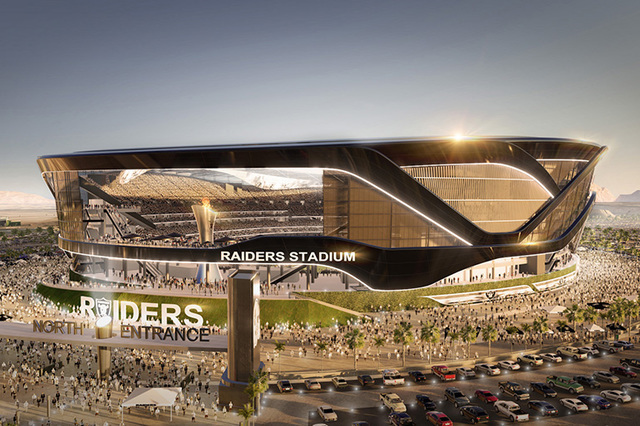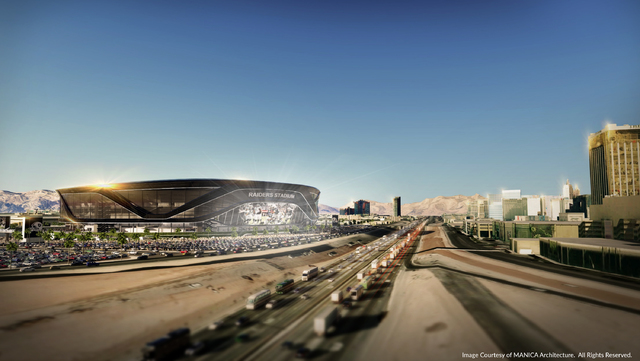In wake of Raiders announcement, things to move fast for stadium board






Steve Hill recently put members of the Las Vegas Stadium Authority board on notice that they’d be meeting twice a month for awhile.
It was a good idea.
With the Oakland Raiders announcing Thursday that they have formally applied for relocation to Las Vegas, things will move quickly as the nine-member board puts agreements in place to build a $1.9 billion, 65,000-seat domed stadium for the team.
Hill chairs the stadium authority board, and he previously chaired the Southern Nevada Tourism Infrastructure Committee, which guided the drafting of the stadium’s enabling legislation. Hill already has his right-hand man, Jeremy Aguero of Las Vegas-based Applied Analysis, working on what’s next for the authority.
LEGAL COUNSEL
At the board’s next meeting, at 1 p.m. Thursday at the Las Vegas Valley Water District’s Mead Room, the authority’s legal counsel is expected to be selected from a group of three firms.
Two firms propose collaborating with out-of-state firms that have experience building stadiums. Hill and Aguero are interviewing representatives of the firms to present a recommendation to the full board for consideration.
The firms under consideration are Las Vegas’ Fennemore Craig, which has 200 lawyers in three states, including former Nevada Gov. and Sen. Richard Bryan; the Las Vegas firm of Brownstein Hyatt Farber Schreck and the Houston firm of Andrews Kurth Kenyon, which worked to develop NRG Stadium, home of the Houston Texans and this year’s Super Bowl LI; and Robert C. Kim, a partner with Las Vegas-based Ballard Spahr, with Jay Lindgren, a partner with Minneapolis-based Dorsey & Whitney, which worked on U.S. Bank Stadium, home of the Minnesota Vikings and site of Super Bowl LII in 2018.
Once legal representation is in place, the pace should pick up on term sheets for lease and development agreements.
The stadium’s funding plan calls for $750 million in bonds financed by a 0.88 percentage-point increase in Clark County’s hotel room tax rate; $650 million from the family of Las Vegas Sands Corp. Chairman and CEO Sheldon Adelson; and $500 million from the Raiders.
“The board will work on making sure that the lease is appropriate, comprehensive and protects the interests of the state of Nevada,” Aguero said in a telephone interview. “Once that’s done, we’ll start working on the development agreement and really, all that has to happen within a year.”
Before anything can start on lease and development deals, Aguero said the league must approve the Raiders’ relocation, a vote that’s expected to occur in March, when NFL owners meeting Phoenix.
The board also must have assurances through a series of financial findings that the Raiders or a partnering group have the financial ability to fund their portion of the stadium.
SITE SELECTION
Selecting the site of the stadium is a matter that will be brought to the authority by the developers, presumably the Raiders and a partner.
The onus is on the developers to bring forward the completed package, which includes the site and the stadium’s design.
“At the point at which a developer is ready — when the Raiders are ready — to bring forward their plan, that’s the point at which the Stadium Authority board will consider everything about the site,” Aguero said.
Two stadium sites have been under study, but one has received the most public attention: 64 acres on four parcels bordered by Russell Road, Hacienda Avenue, Polaris Avenue and Dean Martin Drive. It’s just west of Interstate 15 and the Mandalay Bay resort. The Raiders reportedly have an option to buy the unoccupied land.
Another site, the location of the Bali Hai Golf Club, isn’t considered as desirable because it aligns with McCarran International Airport’s parallel east-west runways.
At the authority’s Jan. 12 meeting, another potential site emerged when Don Murphy, representing real estate developer Fred Nassiri, told board members in public comment that he’d like them to consider 67 acres between Las Vegas Boulevard and I-15, just north of Blue Diamond Road, as a potential site.
STADIUM CONSTRUCTION
For months, officials have talked about construction taking at least 2½ years.
“The Southern Nevada Tourism Infrastructure Committee talked about a 30-month development timeline, which means by the first quarter of next year, we’ve got to be issuing bonds and moving forward on the construction of the project. The developer has the responsibility to put the first $100 million into the project, so they could certainly do something in advance to clear some of those hurdles,” Aguero said.
Aguero noted that nothing formally directs a 2020 startup, but that’s the year the infrastructure committee has been aiming for since the stadium discussion first began about a year ago. Ground isn’t expected to be broken on the stadium until early next year.
There are several other unanswered questions the authority likely will address: who pays an NFL relocation fee, how the UNLV football team’s use of the stadium affects operations, and where the Raiders would play the next few seasons if relocation is approved, among them.
But at least the authority board will have those extra meetings to address them, with tentative meeting dates of Feb. 23 and March 23 added to the already-set dates of Feb. 9 and March 9.
The Review-Journal is owned by the family of Las Vegas Sands Corp. Chairman and CEO Sheldon Adelson.
Contact Richard N. Velotta at rvelotta@reviewjournal.com or 702-477-3893. Follow @RickVelotta on Twitter.












